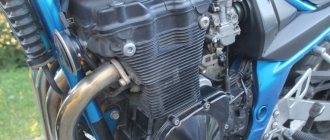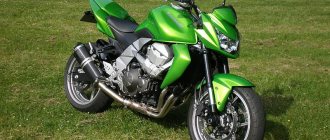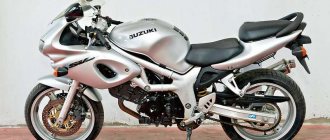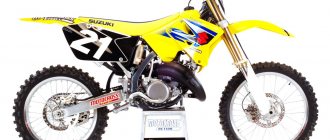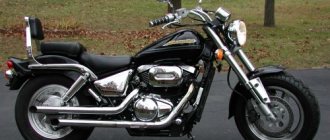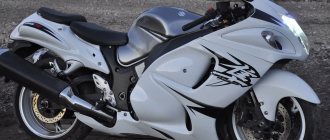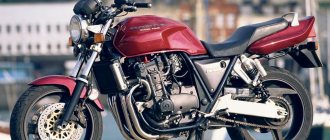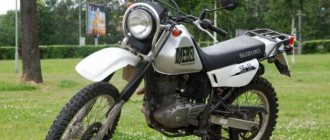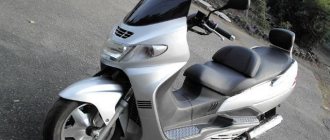Information on the Suzuki GSR 400 motorcycle
Suzuki GSR 400 naked model
appeared in 2006 and was aimed at the Japanese market, as well as the markets of some Asian countries. The model was based on the flagship Suzuki GSR 600 motorcycle with a reduced engine capacity and some minor visual changes. Both models have almost 100% interchangeability of spare parts, except for engine parts and exhaust.
Among the features of the Suzuki GSR 400, it is worth noting an aluminum frame, adjustable rear suspension, an injection engine, a built-in immobilizer, powerful 4-piston brakes and the availability of versions with ABS.
The Suzuki GSR 400 was one of the first modern naked bikes to feature a 400cc inline 4-cylinder engine. Before its introduction, there were only 400 cc classic motorcycles on the market - Honda CB400 (in production), Kawasaki ZRX400 (in production until 2008) and Yamaha XJR400 (in production until 2007). However, the GSR400 did not gain popularity in the Russian Federation, because, firstly, the pricing policy of the motorcycle was such that the GSR400 and GSR600 models were only slightly different in price, and secondly, for the price of the GSR400 (more than 200,000 rubles) you can there were many other, more interesting motorcycle options to consider.
The main competitors of the Suzuki GSR400 in the class:
- Kawasaki ER-4N (2-cylinder)
- Honda CB500F (2-cylinder)
Specifications
Technical characteristics of Suzuki GSR 400:
| Model | Suzuki GSR 400 |
| Motorcycle type | Naked |
| Year of issue | 2006- |
| engine's type | 4-cylinder, 4-stroke, in-line |
| Working volume | 398 cc cm. |
| Cooling | Liquid |
| Bore/Stroke | 54.6 mm x 42.5 mm |
| Compression ratio | 12,2:1 |
| Frame | aluminum, external |
| Number of valves per cylinder | DOHC, 4 valves per cylinder |
| Fuel supply system | injector |
| Ignition type | electronic |
| Maximum power | 52 hp at 11,000 rpm (60 hp at 12,000 rpm - since 2009) |
| Torque | 37 Nm at 9,000 rpm (39 Nm at 10,000 rpm - since 2009) |
| Transmission | 6-speed |
| type of drive | chain |
| Front tire size | 120/70-17 |
| Rear tire size | 180/55-17 |
| Front brakes | 2 discs, 320 mm, 4-piston calipers (optional ABS) |
| Rear brakes | 1 disc, 240 mm, 1-piston caliper (optional ABS) |
| Front suspension | 43 mm telescopic fork (preload adjustable), travel – 130 mm |
| Rear suspension | pendulum with monoshock absorber (adjustable preload and rebound), stroke 134 mm |
| Acceleration 0-100 km/h | 5.3 sec |
| Maximum speed | 190 km/h |
| Seat height | 785 mm |
| Wheelbase | 1435 mm |
| Gas tank capacity | 16.5 l |
| Motorcycle weight | 185 kg – dry |
210 kg – equipped
Reviews
Reviews about Suzuki GSR 400:
Expand Collapse
I own a GSR400 and ride in it myself, happy as an elephant. The handling is simply excellent and of course the view is simply beautiful, but a little expensive. As for sports, I don’t recommend it, first 400, and then 600, as many say. I myself still drive, I’m not going to sit on a 600cc, I have enough for now, and faster than 200 km per hour makes no sense to me, but the question is why?
PS I’ve been skating for season 2, I’m still gaining experience =)
The motorcycle is cool, beautiful, modern. Excellent fully electronic tidy with a built-in gear indicator - for a beginner it’s a great thing) Injector, again. I haven’t really ridden it yet (I just got my license yesterday, but that’s a different story)) but how many times I’ve driven on quiet streets, the dynamics are enough for the eyes) The spare parts, as already mentioned, are all from the GSR600, since, except for the engine, it an exact copy of this motorcycle. Acceleration to hundreds should be around 5 seconds. Maximum speed is about 200 km/h. Take it, you won't regret it for a second)).
I have been the happiest owner of a GSR 400 for three seasons in a row. The motorcycle is great in almost every way, and the CB-400 is a dinosaur in comparison. For 3 seasons I only changed consumables, i.e. Reliability is top notch. The injector, again, compared to the CB. The suspension is beyond praise, the handling is super, the engine is smooth and quite torquey at low end (but only for one, it’s not the same with a passenger), with excellent pick-up after 9000 rpm. It eats little, compared to the GSR 600 it is 1.5-2 times more economical, depending on the driving style. For the city and short trips, a stock motorcycle is just right. I put a higher steering wheel and a windshield on it, which allowed me to do 1300-1400 per day on long-distance trips, although I was tired, but not fatally. On one tank you can actually do from 180 to almost 300-odd kilometers, depending on how you drive. Only after 3 seasons did I really understand what I wanted from a motorcycle. Next season, if I have the money, I’ll change it to a tourenduro. If it doesn’t, I’ll buy a gel lining for the seat so that my backside doesn’t get numb on runs over 1000, and I’ll continue to ride.
Video
- Review and test drive of the Suzuki GSR 400 motorcycle.
Lightweight city naked bike Suzuki GSR 400
, produced for the Japanese domestic market and appearing on the streets of other countries through the efforts of motorcycle dealerships selling used motorcycles, is quite interesting. It's not a technological breakthrough, it's just another 400cc bike, but it's a really good 400cc bike.
400 cubic centimeters is a very popular volume for beginners. The most popular motorcycle in this class can perhaps be called the Honda CB 400, but modern motorcycles like the Suzuki GSR 400 from time to time try to displace recognized road veterans and take away some of the audience's sympathy from them. Moreover, newer motorcycles are often not so different from older models, so, minor improvements, sometimes an injector instead of carburetors, but that’s all. 400 cc motorcycles are traditionally budget-friendly, which means they lack advanced technology. But the GSR 400 deserves attention.
Tuning
Buying a stock motorcycle necessarily means customizing it to suit the driver’s parameters. This increases safety and improves handling and ride quality. Common tuning options:
- installation of protective arches on the engine;
Protection bars on the Suzuki GSR 600 engine
- replacing the stock exhaust (weight 5 kg) with a lighter one;
- replacing brakes with more reliable ones, with a “floating” disc;
- replacing the engine cover with a chrome one;
- replacing shift knobs with shorter ones;
Tuning shift knobs for Suzuki GSR 600
- Replacing the stock driver and passenger footrests with lightweight ones.
The main thing in tuning is not to overdo it, and to use a simple axiom: “A racing car is built around the driver.” After all, a bike is created for the biker, and not vice versa.
On the secondary market, this bike can be bought for about 80,000 - 200,000 rubles.
New motorcycles are not officially supplied to Russia ; they can only be purchased by order.
In Russia, the model from Suzuki - SV 400 C has many fans.
Despite the fact that the debut took place more than 15 years ago, the popularity of the model still remains high.
Both the “Japanese” version (SV400) and the “export version” (SV650) are in demand.
The company’s successful attempt to create a road motorcycle is the Yamaha Tricker 250, with the possibility of using it in a “trial”.
Brief history of the model
- 2006 – start of production and sales of the model.
Model
: Suzuki GSR400 (Japan).
Frame number
: GK7DA-10XXXX.
Factory designation
: GSR400K6.
- 2007 – appearance of modifications with ABS.
Model
: Suzuki GSR400;
Suzuki GSR400 ABS (Japan). Frame number
: GK7DA-10XXXX.
Factory designation
: GSR400K7; GSR400AK7.
- 2008 – model not produced.
- 2009 - the model receives an update to the injection system and a new control unit. Maximum power increases to 61 hp and torque to 39 Nm. The engine becomes more revving.
Model
: Suzuki GSR400;
Suzuki GSR400 ABS (Japan). Frame number
: GK7EA-10XXXX.
Factory designation
: GSR400K9; GSR400AK9.
- 2010 – no significant changes.
Model
: Suzuki GSR400;
Suzuki GSR400 ABS (Japan). Frame number
: GK7EA-10XXXX.
Factory designation
: GSR400L0; GSR400AL0.
- 2011 – no significant changes.
Model
: Suzuki GSR400;
Suzuki GSR400 ABS (Japan). Frame number
: GK7EA-10XXXX.
Factory designation
: GSR400L1; GSR400AL1.
- 2012 – Starting this year, the motorcycle comes with ABS as standard equipment.
Model
: Suzuki GSR400 ABS (Japan).
Frame number
: GK7EA-10XXXX.
Factory designation
: GSR400AL2.
- 2013 – no significant changes.
Model
: Suzuki GSR400 ABS (Japan).
Frame number
: GK7EA-10XXXX.
Factory designation
: GSR400AL3.
- 2014 – no significant changes.
Model
: Suzuki GSR400 ABS (Japan).
Frame number
: GK7EA-10XXXX.
Factory designation
: GSR400AL4.
- 2015 – no significant changes.
Model
: Suzuki GSR400 ABS (Japan).
Frame number
: GK7EA-10XXXX.
Factory designation
: GSR400AL5.
- 2016 – no significant changes.
Model
: Suzuki GSR400 ABS (Japan).
Frame number
: GK7EA-10XXXX.
Factory designation
: GSR400AL6.
- 2017 is the last year of production.
Model
: Suzuki GSR400 ABS (Japan).
Frame number
: GK7EA-10XXXX.
Factory designation
: GSR400AL7.
Article test drive of a suzuki gladius motorcycle
Hi all! Today we have an unusual mini-test. We are testing a motorcycle. Here is the Suzuki Gladius 2012 model year, its price tag is less than 400 thousand rubles, which is very attractive. This is a city car, which is designed to “plow through” our endless traffic jams. Now we will introduce you to its functionality and tell you what it’s like in Moscow traffic jams.
Let's say right away that sitting on it is not very comfortable: a hard, narrow chair, the second passenger is also not given any luxurious conditions, but for city driving, in principle, it is enough when you sit behind the wheel or in the back for 40 minutes maximum.
If you are going to put a rear rack on such a motorcycle, then you need to buy a pannier with additional brake lights, otherwise it will block the main brake light. Now about the functionality: this is “Japanese”, so all the functionality is very clear, simple and understandable. There are no difficulties and you get used to it very quickly. Everything is standard: start button, light switching, turn signals, horn, you can flash the high beams, i.e. there are no difficulties. The instrument cluster is also extremely simple - a large tachometer, indicator lights, and a mileage window, which also displays the speedometer. That's all - you are not loaded with any additional unnecessary information. Before we talk about the technology, let’s say that mirrors are very uncomfortable - you can’t see very well in them. They are, of course, very beautiful, but they do not increase visibility and, frankly speaking, they are not very comfortable to drive with - it is better to change them.
Specifications
Technical characteristics of Suzuki GSR 400:
| Model | Suzuki GSR400 |
| Motorcycle type | naked |
| Year of issue | 2006-2017 |
| Frame | aluminum |
| engine's type | 4-cylinder, 4-stroke, in-line |
| Working volume | 398 cm³ |
| Bore/Stroke | 54.6 x 42.5 mm |
| Compression ratio | 12,2:1 |
| Cooling | liquid |
| Number of valves per cylinder | DOHC, 4 valves per cylinder |
| Fuel supply system | injector with SDTV (Suzuki Dual Throttle Valve), 4x 38 mm |
| Ignition type | fully transistorized |
| Maximum power | 53.0 hp (39.0 kW) at 11000 rpm – GSR400 (2006-2008) |
61.0 hp (45.0 kW) at 12000 rpm – GSR400 (2009-2017)
39.0 Nm (4.0 kg*m) at 10,000 rpm – GSR400 (2009-2017)
Motorcycle versions
The basis for the creation of the chopper was another Suzuki Intruder VS 800 bike, the new product was supposed to be sold only in Japan. But soon after 1999, the manufacturer decided to create a new version, a more modern one. It was called Classic. Among the advantages of the new version are:
- Tank capacity increased from 12 to 17 liters;
- the diameter of the wheel rims decreased from 21 to 16 inches;
- two exhaust pipes are located on the right (on the VS 400 on the sides);
- longer wings.
Also note that the Classic version is considered a real chopper, while the VS was characterized as a cruiser. The older model Suzuki Intruder VS 400 has a narrower front fender and an equally narrow fender. Other differences in the old VS include a double seat, teardrop-shaped fuel tank, a passenger backrest and a short rear wing.
Peculiarities
In addition to time-tired carburetors, the distinctive features of the motorcycle included:
- 2 shock absorber springs in the rear suspension;
- large trunk under the saddle,
- fuel tank on 16 l (300–350 at 1 filling);
The spacious gas tank provides the motorcycle with a good range without refueling.
- brake calipers from Brembo (distinguished by their signature golden color);
- availability of components (despite the fact that the bike is rarely found in Russia - there are no problems with original parts, there is no need to specially order anything);
- This also includes unification - if you don’t have the necessary parts, you can put parts from a bandit of a similar volume on a motorcycle, or from a Honda (Sibihi 400);
- good handling and maneuverability;
- small dimensions and weight (noted by girl bikers);
Ideal for row spacing - high seating, small width, mirrors do not protrude beyond the grips.
Modifications
Suzuki IMPULSE GSX 400 S is the same motorcycle, only with a fairing.
The bike has only one official modification - Suzuki GSX 400 S. The filling of the model is the same. The only difference is the presence of a front half-fairing. This model is sometimes labeled as Type S.
But there is another motorcycle in the 400 line with the same abbreviation. Suzuki GSX 400 Inazuma . Also the model is only for Japanese use and was also available in other countries' markets.
and competitors
Honda CB 400.
Kawasaki ZZR 400.
Yamaha XJR 400.
The situation with competitors is quite interesting. Among them there are models from all Japanese manufacturers, and bike components are also suitable from any of the listed ones.
- For Honda, this is the legendary CB 400 .
- For Kawasaki - the no less legendary zizer, ZZR 400 .
- And Yamaha introduced the XJR 400 .
